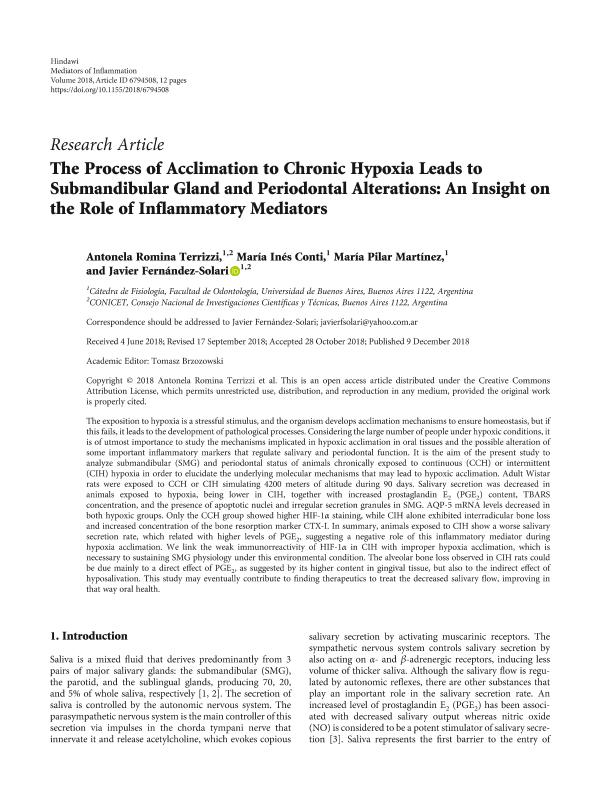Artículo
The process of acclimation to chronic hypoxia leads to submandibular gland and periodontal alterations: An insight on the role of inflammatory mediators
Terrizzi, Antonela Romina ; Conti, Maria Ines; Martinez, Maria del Pilar; Fernández Solari, José Javier
; Conti, Maria Ines; Martinez, Maria del Pilar; Fernández Solari, José Javier
 ; Conti, Maria Ines; Martinez, Maria del Pilar; Fernández Solari, José Javier
; Conti, Maria Ines; Martinez, Maria del Pilar; Fernández Solari, José Javier
Fecha de publicación:
12/2018
Editorial:
Hindawi Publishing Corporation
Revista:
Mediators of Inflammation
ISSN:
0962-9351
Idioma:
Inglés
Tipo de recurso:
Artículo publicado
Clasificación temática:
Resumen
The exposition to hypoxia is a stressful stimulus, and the organism develops acclimation mechanisms to ensure homeostasis, but if this fails, it leads to the development of pathological processes. Considering the large number of people under hypoxic conditions, it is of utmost importance to study the mechanisms implicated in hypoxic acclimation in oral tissues and the possible alteration of some important inflammatory markers that regulate salivary and periodontal function. It is the aim of the present study to analyze submandibular (SMG) and periodontal status of animals chronically exposed to continuous (CCH) or intermittent (CIH) hypoxia in order to elucidate the underlying molecular mechanisms that may lead to hypoxic acclimation. Adult Wistar rats were exposed to CCH or CIH simulating 4200 meters of altitude during 90 days. Salivary secretion was decreased in animals exposed to hypoxia, being lower in CIH, together with increased prostaglandin E 2 (PGE 2 ) content, TBARS concentration, and the presence of apoptotic nuclei and irregular secretion granules in SMG. AQP-5 mRNA levels decreased in both hypoxic groups. Only the CCH group showed higher HIF-1α staining, while CIH alone exhibited interradicular bone loss and increased concentration of the bone resorption marker CTX-I. In summary, animals exposed to CIH show a worse salivary secretion rate, which related with higher levels of PGE 2 , suggesting a negative role of this inflammatory mediator during hypoxia acclimation. We link the weak immunorreactivity of HIF-1α in CIH with improper hypoxia acclimation, which is necessary to sustaining SMG physiology under this environmental condition. The alveolar bone loss observed in CIH rats could be due mainly to a direct effect of PGE 2 , as suggested by its higher content in gingival tissue, but also to the indirect effect of hyposalivation. This study may eventually contribute to finding therapeutics to treat the decreased salivary flow, improving in that way oral health.
Palabras clave:
HYPOXIA
,
SALIVARY GLANDS
,
INFLAMATION
Archivos asociados
Licencia
Identificadores
Colecciones
Articulos(OCA HOUSSAY)
Articulos de OFICINA DE COORDINACION ADMINISTRATIVA HOUSSAY
Articulos de OFICINA DE COORDINACION ADMINISTRATIVA HOUSSAY
Citación
Terrizzi, Antonela Romina; Conti, Maria Ines; Martinez, Maria del Pilar; Fernández Solari, José Javier; The process of acclimation to chronic hypoxia leads to submandibular gland and periodontal alterations: An insight on the role of inflammatory mediators; Hindawi Publishing Corporation; Mediators of Inflammation; 2018; 12-2018; 1-12; 6794508
Compartir
Altmétricas



